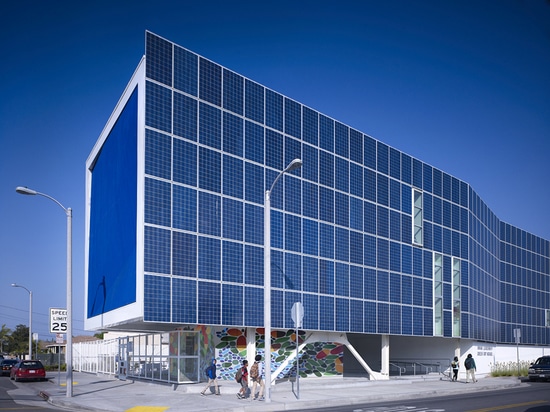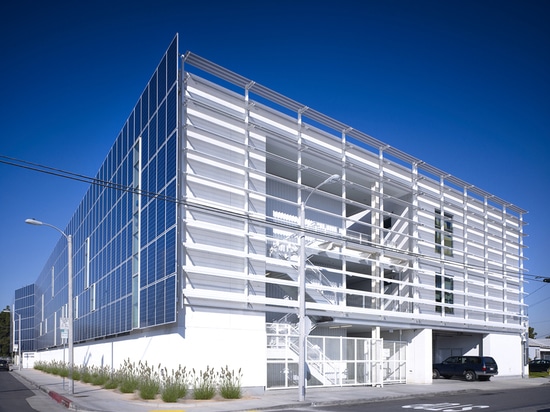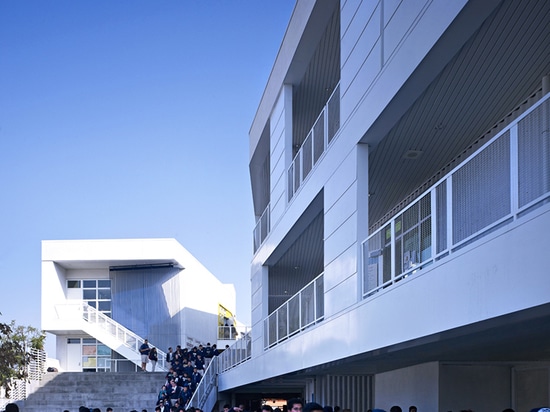
#PUBLIC ARCHITECTURE PROJECTS
Animo Leadership High School
Santa Monica, California's Brooks + Scarpa Architects is known for a strong commitment to sustainable architecture that is often expressed on the outside of their buildings
Colorado Court, an apartment building from 2002, is an early example, covered in solar panels and 100% energy neutral. The architects answered a few questions about the building.
Please provide an overview of the project.
This new public school for 500 students is located in a tough South Los Angeles neighborhood almost directly under the flight path into LAX and adjacent to the very busy 105 Century freeway. The design was influenced by the New Orleans architects Curtis and Davis who designed and built many schools in the early 1950s in Louisiana. Their designs adapted to the harsh southern climate without using air conditioning, creating sustainable light filled and poetic spaces for kids to learn.Similarly, this project is designed to enhance passive sustainable strategies. It allows for abundant natural light, ventilation and view, while the building form is shaped to shade itself and inducing airflow. The south facade is clad with 650 solar panels that shade the building and provides 75% of the energy needs for the school. Implementing these strategies will reduce carbon emissions by over 3 million pounds.
Taking full advantage of the region’s temperate climate, the designers eschewed the fully contained “big box” idiom of conventional schools on the primary use site. Instead, a landscaped courtyard with a multifunctional terracing bleacher flows into the open-air courtyard, lending the school the appeal of a collegiate campus and offering significant environmental benefits—improving daylighting and access to fresh air both inside and out—while providing substantial cost savings by limiting artificial lighting and thermal conditioning to the smaller enclosed spaces.
What are the main ideas and inspirations influencing the design of the building?
The greatest challenge for the new Animo Leadership High School was posed by the site: undersized and split into two parcels separated diagonally across an intersection. Compounding these issues is the school’s location, near Los Angeles International Airport and within a quarter mile of the 105 Freeway—adding noise and air quality to the list of concerns. The parcels’ small size and disjointed nature made the school’s organization a paramount priority. The solution was to concentrate the programming with the most daily activity on one site—grouping classrooms, administrative offices, and support facilities such as the library and laboratories—leaving the other site to accommodate large assembly spaces that incur less frequent traffic, in this case the multipurpose gymnasium and a large studio space for music and dance.
With a project target of certification by CHPS (Collaborative for High Performance Schools) and/or LEED Certification at the minimum, aesthetics, sustainability, and cost-effectiveness were considered in every design decision. The south facade is clad with 650 solar panels. When completed the project is expected to reduce carbon emissions by over 3 million pounds.
Taking full advantage of the region’s temperate climate, the designers eschewed the fully contained “big box” idiom of conventional schools on the primary use site. Instead, a landscaped courtyard with multifunctional “bleacher” terracing flows into the open-air covered lobby and the multilayered paseo, lending the school the appeal of a collegiate campus and offering significant environmental benefits—improving daylighting and access to fresh air both inside and out—while providing substantial cost savings by limiting artificial lighting and thermal conditioning to the smaller enclosed spaces.Faceted, ribbed screens appear as a façade motif; both visually connecting the school with the community and modulating light to protect from the building from unwanted solar heat gain. Solar panels form the screen system on the longest façade of the building; augmented by additional panels on the roof, they will provide clean, renewable energy for the school. On the other site, the multipurpose gymnasium and music/dance studio are housed on either end of a long 35’-high building with shared support space in between. Glazed 10’-high roll-up doors that spread across both ends maximize daylighting and views, and can be opened to extend activity into the courtyards beyond. Numerous other sustainable design features and environmentally friendly materials are incorporated throughout the entire project.
Were there any significant challenges that arose during the project? If so, how did you respond to them?
Because it is a school, we had to submit the drawings to the Division of State Architect (DSA, a government entity in California) for permitting. This is typically a rigorous review, and we had a tight design schedule due to the overall project schedule.
During construction, poor soil was discovered, despite the soil boring tests that were done with the initial Geo Technical Report. The Report had to be amended and the soil replaced. Because the site was in the residential area, the north property line was shared with a homeowner requiring careful consideration and planning so as to not distribute them or their land, as well as gain access when needed. The construction was handled by a Construction Management firm, opposed to a General Contractor, thus in reality there were 13 Prime Contractors accessing the site at different times without any coordination between these trades.
How does the building relate to contemporary architectural trends, be it sustainability, technology, etc.?
The building is very sustainable, which could be termed a “trend.” (Although I believe sustainability will remain, and not become unpopular like "trends" do.) It is designed with both passive and active sustainable features. The central courtyard and balconies in the building allow for natural cross ventilation, as well as daylighting from two sides. It is designed to LEED standards. The entire south façade is clad in PV panels, providing approximately 75% of the schools energy needs.
How would you describe the architecture of [State] and how does the building relate to it?
The architecture in the State of California varies dramatically, depending on Northern or Southern, and even between counties and urban or rural areas. Animo Leadership is not out of character for Los Angeles or it’s specific location. It is set in a semi-residential area, so we purposely kept the height of the building to a minimum, so as to not over shadow the mostly one and two story surrounding buildings. There are many architects in the area doing architecture similar in style to ours, however it is still not the majority of the landscape.





